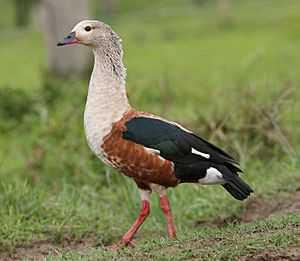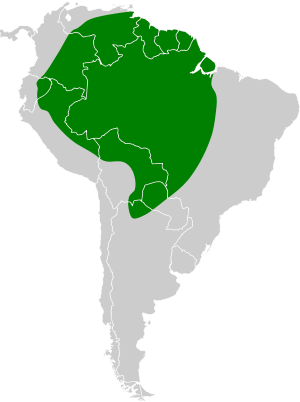Orinoco goose facts for kids
Quick facts for kids Orinoco goose |
|
|---|---|
 |
|
| Conservation status | |
| Scientific classification | |
| Genus: |
Neochen
|
| Species: |
jubata
|
 |
|
| Synonyms | |
|
Oressochen jubatus |
|
The Orinoco goose (Neochen jubata) is a type of waterfowl that lives near water. It is considered a Near Threatened animal, meaning its population is decreasing. You can find this goose in most countries in mainland South America, but not in Chile, French Guiana, Suriname, or Uruguay.
Contents
Understanding the Orinoco Goose Family Tree
The way scientists classify the Orinoco goose is still being discussed. Some groups, like the International Ornithological Committee (IOC), believe it belongs in its own group, called Neochen. However, other groups, like the American Ornithological Society, think it should be grouped with the Andean goose in a different genus called Oressochen. This idea came from a study in 2014 that looked at the birds' DNA.
Scientists have also found fossils of two ancient relatives of the Orinoco goose. These fossils, named Neochen pugil and N. debilis, were found in South America. The Orinoco goose we see today is a single species, meaning there are no different subspecies of it.
What Does the Orinoco Goose Look Like?
The Orinoco goose is a medium-sized bird, about 61 to 76 centimeters (24 to 30 inches) long. Male geese are heavier, weighing around 1.8 kilograms (4 pounds), while females weigh about 1.3 kilograms (2.9 pounds).
Adult males have a light, off-white head, neck, and chest. Their back feathers are gray with white edges. They have a bright orange band across their upper back and sides. Their wings are black with a wide white patch. The top part of their beak is black, and the bottom part is mostly red. Their legs and feet are a bright salmon red.
Female geese look similar to males. However, their head and neck might have a duller color. They also have less orange on their sides and darker markings on their belly. Their legs and feet are more of a dull orange color than bright red.
Where Orinoco Geese Live and Their Homes
The Orinoco goose lives in many parts of South America. You can find them from Venezuela, south through Colombia, eastern Ecuador, eastern Peru, and Bolivia. They also live in northern Argentina and across central Brazil. There's even a small group living near the border of northern Brazil and Guyana.
These geese prefer wet grasslands, also known as savannas. They also like the edges of large freshwater wetlands during the rainy season. When the dry season comes, they move to river beaches and oxbow lakes in the Amazon Basin.
Orinoco Goose Behavior
Migration and Movement
Some Orinoco geese stay in the same area all year, like those in the Llanos region of Venezuela and parts of Bolivia. However, other groups travel long distances. For example, some geese from Bolivia fly about 700 kilometers (435 miles) to Manú National Park in Peru to breed. Others travel almost 1,000 kilometers (620 miles) along the Río Juruá in western Brazil. Scientists are still learning about the migration patterns of other Orinoco goose populations.
What Orinoco Geese Eat
The Orinoco goose is a herbivorous bird, meaning it eats only plants. Their main diet includes leaves and the seed heads of grasses. They also eat algae found in still water along rivers and oxbow lakes.
These geese usually look for food during the day in open areas close to water. Sometimes, they also feed at night. They fly between their feeding spots and resting places during sunrise and sunset.
Reproduction and Life Cycle
The breeding season for Orinoco geese changes depending on where they live and how much rain falls. In areas south of the Equator, they usually nest between April and November, which is mostly a dry season. In Venezuela, most geese nest during the wet season, from July to August, though some may nest at other times.
Orinoco geese build their nests in holes or hollows. They prefer natural holes in trees, like those formed when a branch breaks off or the wood rots. They don't usually use holes made by other birds. Sometimes, they might even compete with owls and parrots for good nesting spots. There are a few reports of them nesting on the ground in thick grass, but this is rare.
Sometimes, a female Orinoco goose will lay her eggs in another goose's nest. This is called "brood parasitism." In one study, nests that were not "parasitized" had about seven eggs. But nests where another female laid eggs had around 19 eggs! Interestingly, the nests with more eggs often had a higher success rate.
Orinoco geese form strong pairs that stay together all year. During the breeding season, they become very protective of their nesting area. The male goose guards the female while she sits on the eggs.
How Orinoco Geese Communicate
The Orinoco goose is a very noisy bird! During the breeding season, males make high whistles and deep honks. Females make a loud cackling sound. Males also make a sharp, whistling "zree" and a series of hollow, reedy whistles. Females make a low, guttural honking sound, like "gu'rump, gur'rump, gur'rump." Both male and female geese make a special nasal honking sound, like "unnhh?". Young geese make soft, chicken-like peeps.
Protecting the Orinoco Goose
The IUCN (International Union for Conservation of Nature) has listed the Orinoco goose as "Near Threatened." This means that while they live in a large area, their numbers are going down. Scientists estimate there are between 10,000 and 25,000 adult geese left, and their population is slowly shrinking.
The main reason for this decline seems to be hunting. In protected areas where hunting is not allowed, the goose populations are stable. Another threat is that their habitat is being turned into rice farms. To help these geese, conservation efforts should focus on protecting riverbanks, sandy beaches along rivers, and their migration paths.
See also
 In Spanish: Ganso del Orinoco para niños
In Spanish: Ganso del Orinoco para niños


